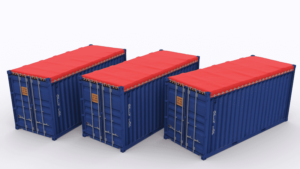By Hari Menon
Let us take a look at the dimensions of a TEU here.
The external length of a twenty-foot equivalent GP unit is 20 feet. It has a width of 8 feet and a height of 8 feet 6 inches. Its internal dimensions for loading are a length of 19 feet 4 inches, a width of 7 feet 8 inches, and a height of 7 feet 10 inches.

There might be minor differences in measurements between containers made by different manufacturers but remember that they all have to fit correctly on the trucks they are loaded, meet the specifications of the lifting and handling equipment that are used in seaports, as well as in the container storage area of a ship.
Pallets
Typically, a general-purpose TEU can hold about 11 wooden pallets arranged in a single stack. The number of pallets can go up to 22 when pallets are double stacked. Again, a lot of these numbers depend on whether standard pallets or euro-pallets are used. It also depends on the height of each packed pallet.
While the International Standards Organization (ISO) has set the standards for uniform pallet size and quality through its ISO standard 18333: 2014, the standard pallets and the euro-pallets vary in size. Dimensions of the former are 48 inches X 40 inches while the latter has dimensions of 47.24 inches X 31.50 inches.
Container Load
What is the weight that can be loaded inside a twenty-foot container? Logistics and shipping companies normally load up to 24000 kilograms (24 metric tons) of cargo in a TEU.
An empty container of this size weighs 2280 kilograms (2.24 metric tons). Hence the total weight of a fully laden twenty-foot container will be 26280 kilograms (26.28 metric tons).
The actual weight-bearing capacity of a twenty-foot container is 28200 kilograms (28.2 metric tons) and its fully laden total weight is 30480 kilograms (30.48 metric tons).
Cubic meter (CBM) is the standard unit to measure freight volume. If we look at the overall volume that a twenty-foot GP container can take, it is about 33 CBM (cubic meters). However, the actual usable freight volume will only be in the range of 25 to 28 CBM.
Now, that brings us to the question of what is the basis of charging freight by the shipping company? When a business leases a container for transporting cargo, the charge will be for the full container irrespective of whether it fully or partially filled.
However, for Less-than Container Load (LCL) shipments, according to the convention, if the weight of cargo exceeds 1000 kilograms (1 ton) then the weight is used for the calculation of freight charges.
Only when the weight is below 1 ton is the volume in CBM considered for the calculation of freight.
*To be continued
shippingposition
Kindly like us on Facebook/twitter















